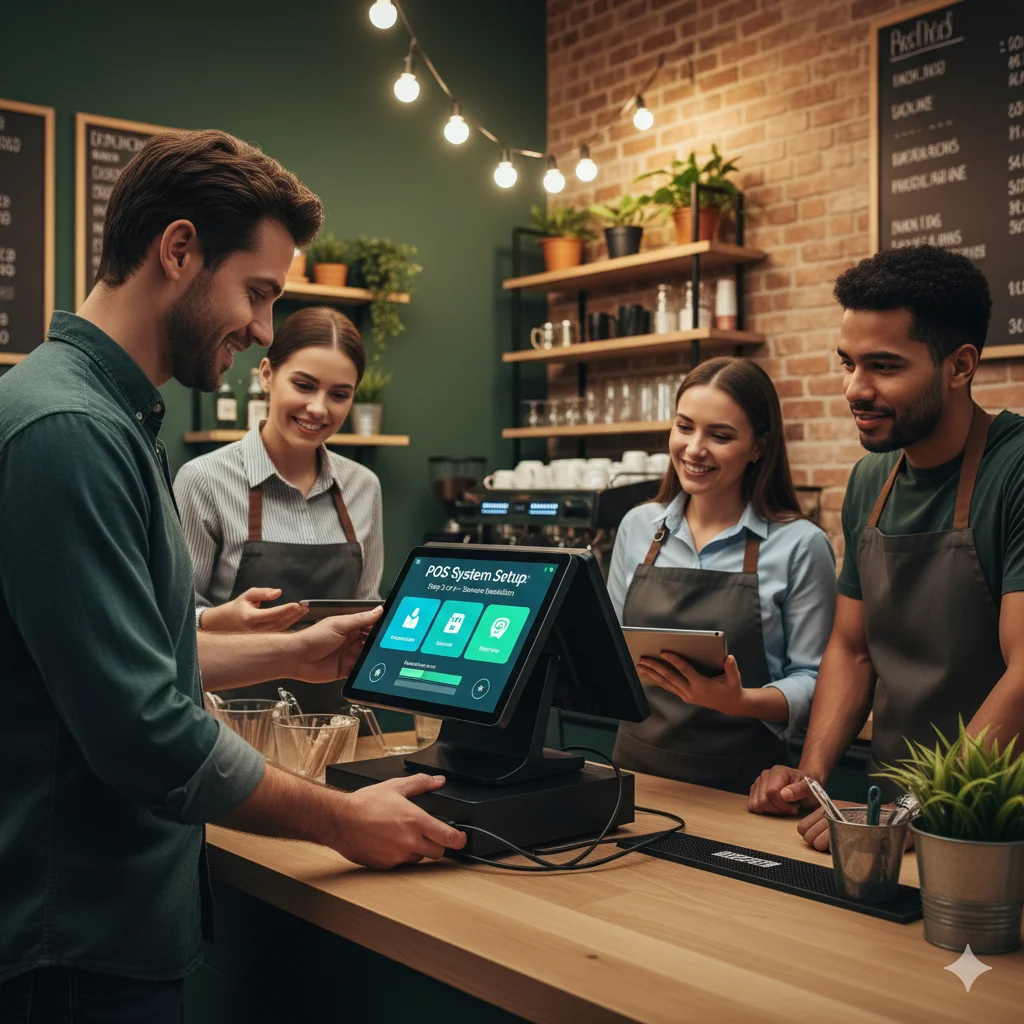In today’s competitive food and beverage (F&B) industry, success depends not only on culinary quality but also on operational precision. Restaurants and cafés juggle dine-in, takeaway, and delivery orders while managing staff, stock, and customer satisfaction. In this environment, a POS system for restaurants and cafés is no longer a luxury—it is a necessity.
According to Fortune Business Insights (2023), the global POS software market was valued at USD 12.7 billion in 2022 and is projected to grow to USD 26 billion by 2030, driven largely by adoption in hospitality and F&B sectors. This trend reflects the increasing reliance on technology for speed, accuracy, and profitability in restaurant management.
What is a POS System for Restaurants & Cafés?
A Point of Sale (POS) system is more than just a digital replacement for the traditional cash register—it has become the central hub of modern food and beverage (F&B) businesses in Malaysia and worldwide. Unlike outdated systems that only handle payments, a POS integrates both hardware and software to streamline sales, manage inventory, process multiple payment methods, and generate valuable business insights through real-time data analytics. This makes it a vital technology investment for restaurants, cafés, and QSR (Quick Service Restaurants) that want to scale efficiently while reducing operational bottlenecks.
The core functions of a POS system go beyond simple transactions. It ensures seamless transaction management across dine-in, takeaway, and delivery channels, helping F&B operators provide a smooth customer experience. It supports multi-payment options including cash, debit and credit cards, QR Pay, and e-wallets—crucial in Malaysia’s increasingly cashless economy. With inventory oversight, restaurant owners can track stock and ingredient levels in real time, minimizing waste and ensuring menu availability. Meanwhile, automated analytics and reporting empower managers to monitor sales performance, staff productivity, and profit margins, enabling data-driven decision-making.
From a hardware perspective, POS systems usually feature touchscreen tablets, receipt printers, cash drawers, and barcode scanners, providing flexibility for different business models. On the software side, cloud-based POS solutions are rapidly gaining adoption in Malaysia due to their scalability, security, remote monitoring, and easy integration with third-party apps such as delivery platforms and accounting tools (Statista, 2024). This shift towards cloud POS highlights the industry’s move from static systems to smart, connected ecosystems that improve operational efficiency and customer satisfaction.
By integrating transaction processing, payment flexibility, inventory management, and advanced analytics into a single platform, a POS system is no longer optional—it is an essential digital backbone for any F&B business aiming to compete in today’s fast-paced market.
Why Do Restaurants & Cafés Need a POS System?
Operating a café is very different from managing a retail store. Unlike retail, cafés and restaurants work in a high-volume, fast-paced environment, where every second counts and even a small operational error can result in customer dissatisfaction, order mistakes, or revenue loss. For this reason, many F&B operators in Malaysia and across the globe are shifting towards specialized café POS systems designed to handle the unique demands of the hospitality industry.
The challenges faced by cafés without a POS system are considerable. Staff must juggle dine-in, takeaway, and delivery orders simultaneously, often leading to confusion during peak hours. Seasonal promotions and frequent menu updates create additional complexity, especially when prices or items change daily. On top of that, cafés must efficiently manage tables, reservations, and split bills, which becomes increasingly difficult when done manually. Another recurring pain point is the need to rapidly train new staff in an industry notorious for high turnover rates.
Without a dedicated café POS system, these tasks can lead to order errors, delayed service, and time-consuming manual reporting, all of which negatively affect both customer experience and profitability. By contrast, a modern café POS streamlines day-to-day operations by making ordering, billing, and analytics faster, more accurate, and highly scalable. It centralizes operations into one intuitive system—reducing training time, minimizing mistakes, and empowering business owners with real-time insights that help improve efficiency and profitability.
In short, a café POS system is not just a convenience but a critical business tool that enables restaurants and cafés to meet customer expectations, manage high traffic, and stay competitive in an increasingly digital-first F&B industry.
Key Features of a Restaurant POS System
Modern POS software for restaurants and cafés extends far beyond basic billing. It is designed as a comprehensive operational platform.
Essential Features to Look For:
- Order Management & Kitchen Synchronization
- Orders entered digitally are sent directly to the kitchen or barista station.
- Eliminates handwritten mistakes and reduces service delays.
- Menu & Pricing Control
- Add or remove menu items instantly.
- Adjust pricing across multiple branches in real time.
- Highlight limited-time promotions or seasonal specials.
- POS Payment Processing
- Support for cash, debit/credit cards, QR codes, and e-wallets (GrabPay, Touch ’n Go eWallet).
- Contactless transactions for faster, safer payments.
- Bill-splitting for groups and reservations.
- Inventory & Ingredient Tracking
- Real-time monitoring of ingredient usage.
- Automatic low-stock alerts to prevent shortages.
- Helps minimize food waste, a major concern in F&B (FAO, 2021).
- Sales Reporting & Analytics
- On-demand generation of daily, weekly, and monthly reports.
- Identification of best-selling items.
- Performance metrics for staff efficiency.
- Peak-hour analysis to optimize staffing.
How POS System Work in Daily Café Operations
To illustrate, consider a busy café during morning rush hour:
- Orders are placed at the counter or through self-service kiosks.
- POS sends tickets directly to the kitchen and coffee bar.
- Customers pay via cards, QR codes, or e-wallets within seconds.
- Managers review end-of-day sales reports to optimize restocks and staffing.
This streamlined workflow is nearly impossible without restaurant POS software. Manual systems would result in slower service, higher error rates, and dissatisfied customers.
Benefits of Using a POS System in F&B
The advantages of adopting a POS system for restaurants and cafés are both immediate and long-term.
Operational Benefits:
- Faster Service – Reduce queues and serve more customers per hour.
- Accuracy – Minimize costly order mistakes.
- Loss Prevention – Track every transaction to reduce theft or miscalculations.
- Ease of Training – Staff adapt quickly, reducing onboarding costs.
- Smart Decision-Making – Leverage POS analytics for data-driven strategies.
Research by Deloitte (2021) highlighted that restaurants using POS analytics saw a 7–10% increase in profit margins through optimized pricing and inventory control. You can check our article about which POS System suit you.
Choosing the Best POS System for Your Business
Not every POS system suits every F&B establishment. Business owners must align their choice with operational needs, service models, and scalability goals.
Matching POS to Business Type:
- Small Cafés – Affordable, easy-to-use POS with quick setup and essential features.
- Full-Service Restaurants – Advanced POS with table management, split billing, and loyalty integration.
- Growing F&B Businesses – Cloud POS with scalability, multi-branch management, and delivery app integration.
POS Selection Checklist:
- Is the system user-friendly for staff training?
- Does it support all major payment methods?
- Can it generate real-time sales reports?
- Does it integrate with delivery platforms (e.g., GrabFood, Foodpanda)?
- Is the pricing model transparent and scalable?
While the advantages of a modern Point of Sale (POS) system are undeniable, not every vendor delivers the same level of quality, reliability, or support. Choosing the wrong POS can lead to higher costs, inefficient operations, and frustrated staff, which ultimately affects your customers. For café, restaurant, and retail owners in Malaysia, recognizing the red flags before signing a contract is crucial to avoid long-term headaches.
Key Cautionary Signs When Evaluating a POS Vendor:
-
Hidden transaction fees or unclear contracts – Some providers charge additional processing fees, service charges, or lock businesses into long-term agreements with unfavorable terms. Always check the fine print.
-
Poor integration with delivery and accounting systems – A POS that cannot connect seamlessly with food delivery apps (GrabFood, Foodpanda) or accounting software will create data silos and manual work.
-
Lack of local customer support and training – Without responsive, local-based support, resolving technical issues during peak hours becomes a nightmare. Training is also vital, especially in industries with high staff turnover.
-
Limited offline functionality – Internet disruptions happen, and a POS that stops working without Wi-Fi can cause major downtime, lost sales, and unhappy customers.
Pro tip: Always request a free trial or demo before making a final decision. This hands-on approach allows you to test usability, compatibility, and scalability in real-world conditions—ensuring the POS fits your specific business needs.
Conclusion
A POS system for restaurants and cafés is no longer optional—it is a core component of modern F&B success. From streamlining daily operations to delivering insights that fuel growth, the right POS ensures profitability, scalability, and customer satisfaction.
Whether managing a boutique café or a multi-branch restaurant, the right investment in POS technology can determine whether a business thrives or struggles in Malaysia’s competitive F&B market.





